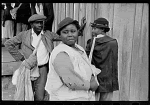
While I did find this series of videos to be entertaining, I didn't find it at all surprising. The history of photography sounded spot-on, almost as if I'd heard this story before.
Anyhow, what I found most entertaining was this all to familiar battle between the 'roguish' pioneers of the new art form and the old vanguard of art 'connoisseurs.' This is essentially how art progresses and is made! Here comes this group of 'new' artists, toting their 'new' contraptions and devices, taking photographs of everything, and then comes this old group who, upon finding out what exactly is infiltrating their art world, promptly frown at this and say 'wait a minute, that's not art!' What's best is that sometimes this old group is completely right; but in this case they were not---in any event, the old guard's intentions are always good, aren't they? Anyhow, even upon its outset, the art photography ethos was always well disposed to the idea of photographic manipulation, and in being so this early collection of photographic artists correctly predicted the idea of digital manipulation which would completely pervade the world a century later. Thus it came about that the 'pure' image was never the domain of the 'artist' per se, but rather the concern of the average recreational photographer.
This early tale of photographic art's humble beginnings also displays the fact that it is not ever technology which creates the artist, but rather the artist who uses technology to create his art. This sounds simple enough, but it is in fact opposed to the general opinions of today that hold everyman as being capable of producing art if he is merely given the same tools. Early photographers were almost uniformly given the same means---of course, as the technology hadn't progressed in such a fashion as to create top- and bottom- line devices---yet it was the predisposition of the artist which decided to create 'art' rather than the average family picnic snap-shot. In any event it proves that art is art and not some other thing like, let us say, science.
I've chosen my picture, a mere thumbnail of a great Ansel Adams photo, because I think that Adams almost single handedly created the genre of landscape photography. Most landscape photography today can be seen as referencing Adams directly, even 'visionary' photographers like Simon Marsden.
-Bryce VanHoosen-
















